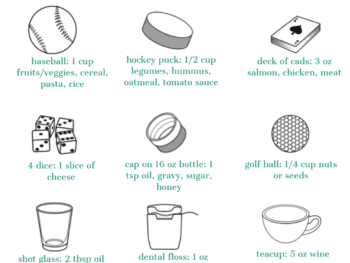Below is my blog post for Huffington Post “FDA to update food label serving sizes.”
You can also read it HERE.
FDA (Food and Drug Administration) is seeking public comment on the proposed revisions to the food labels (NOTE: deadline August 1).
You can still comment on the following:
1. Serving Sizes: Docket FDA-2004-N-0258
2. Nutrition and Supplement Facts Label: Docket FDA-2012-N-1210
Below are my comments on FDA’s proposal to update the serving sizes.
Dr. Margaret Hamburg
Commissioner
Food and Drug Administration
10903 New Hampshire Avenue
Silver Spring, MD 20993
Re: Food Labeling: Serving Sizes of Foods That Can Reasonably Be Consumed at One-Eating Occasion; Dual-Column Labeling; Updating, Modifying, and Establishing Certain Reference Amounts Customarily Consumed; Serving Size for Breath Mints; and Technical Amendments; Docket No. FDA-2004-N-0258 (Formerly Docket No. 2004N-0456)
Dear Commissioner Hamburg:
I strongly support the United States Department of Health and Human Services (HHS), Food and Drug Administration’s (FDA) proposal to revise the Reference Amounts Customarily Consumed (RACCs) for certain food and beverage products. I have been researching trends in growing portion sizes as well as educating clients and students on understanding information about food label serving sizes and the relationship between portion sizes, calories, and weight management.
Below I make the following points:
I. I strongly support the FDA’s proposal to revise the Reference Amounts Customarily Consumed (RACCs) for certain products;
II. FDA should revise serving sizes for additional foods;
III. FDA should pro-actively address concerns about the possible unintended consequence that some consumers view serving sizes as portion recommendations.
IV. FDA should require that serving size information be displayed in ounces instead of gram weights.
I appreciate the chance to comment. I urge FDA to expeditiously finalize this rule, as well as the companion proposal regarding revisions to the Nutrition Facts Panel.
I. I strongly support the FDA’s proposal to revise the Reference Amounts Customarily Consumed (RACCs) for certain products.
I strongly support the FDA’s proposal to revise the serving size for certain foods and beverages to reflect the way Americans eat today. Labels that list the nutrition information for outdated serving sizes may be deceptive to consumers, and I commend FDA for its recognition of the need to revise the RACCs for specific foods. I also commend FDA’s proposal to require that packaged foods and drinks typically consumed in one sitting be labeled as a single serving, and that manufacturers declare the calorie and nutrient information for the entire package.
As FDA notes, the original RACCs were established using U.S. Department of Agriculture (USDA) survey data from 1977-1978 and 1987-1988. Consumption patterns have changed over the past few decades. For example, on average, American adults aged 20 and older consumed 240 more calories per day in 2009-2010, when compared to levels in 1971-1975, mostly due to increased portion sizes of foods and beverages.
The portion sizes of commonly consumed foods have increased considerably since the late 1970s; one reason for the increase in obesity rates may be that people are eating larger food portions, and therefore, more calories. The trend toward growing portion sizes has been observed for packaged foods and drinks as well as energy dense foods served in the highest selling takeout places, restaurants and fast-food outlets. Many food portions are now two to five times larger than their original size.
II. FDA should revise serving sizes for additional foods.
Using consumption data from the most recent National Health and Nutrition Examination Surveys (NHANES), 2003-2008, the agency proposes to modify an existing RACC if the median consumption increased or decreased by at least 25 percent, compared to the RACC established in 1993. The FDA states that it also took into account other factors when deciding to modify an existing RACC, including information from citizen petitions, industry comments, and market trends. I urge the FDA to consider:
• Pegging the proposal to set new RACCs only for changes of 25 percent or greater neglects some categories that deserve re-evaluation due to their impact on public health. Under the law, FDA is required to define the reference amounts for foods based on the amount of food customarily consumed. See Pub. L. 101.9(b)(1); 58 F.R. 44039 et seq. Therefore, I urge FDA to update the RACCs based on actual food consumption data as opposed to allowing for a 25% or greater change
III. FDA should pro-actively address concerns about the possible unintended consequence that some consumers view serving sizes as portion recommendations.
I recognize that the RACCs used to calculate serving sizes are required to be based on the amount of food people customarily consume, and are not recommended amounts of food to eat. However, given the likelihood of confusion among some consumers, I strongly recommend that the FDA include clarifying language on the label by either: 1) denoting the serving size provided as a “typical” serving size or 2) including a footnote to clarify that “the serving size is based upon the amount typically consumed, and is not a recommended portion size.”
Other ideas for communicating a similar distinction should also be tested in consumer research by the agency. I also support additional education efforts to increase consumer understanding of the meaning of the change in serving sizes, as FDA suggests in its proposal.
IV. FDA should require that serving size information be displayed in ounces
instead of gram weights.
From my experience as an educator and clinician, few people understand the meaning of gram weights, as we do not rely on the metric system in the U.S. While I applaud listing food amounts in common household measures ( cups, tablespoons) as well, I urge the FDA to require that serving size information be displayed in ounces instead of gram weights. The term “ounces” as opposed to “grams” is used by USDA’s MyPlate.gov and is also more easily recognizable to US citizens.
References
Food and Drug Administration, Food Labeling; Serving Sizes, Jan. 6, 1993, 58 FR 2229, at 2236-2237.
Ford ES, Dietz WH, “Trends in energy intake among adults in the United States: findings from NHANES. Am J Clin Nutr 2013;97:848-53.
Young LR , Nestle M. Reducing Portion Sizes to Prevent Obesity: A Call to Action. Am J Prev Med 2012;43:565-568.
Young LR, Nestle M. The contribution of increasing portion sizes to the obesity epidemic. Am J Pub Health 2002;92:246-249.
Nielsen SJ, Popkin BM. Patterns and trends in food portion sizes, 1977-1998. JAMA 2003;289:450-453.
Young LR. The Portion Teller Plan. New York, NY: Three Rivers Press, Random House, 2005.
Young LR, Nestle M. Expanding portion sizes in the US marketplace: Implications for nutrition counseling. J Am Diet Assoc 2003;103:231-234.
Food and Drug Administration, Food Labeling: Serving Sizes of Foods That Can Reasonably Be Consumed at One-Eating Occasion; Dual-Column Labeling; Updating, Modifying, and Establishing Certain Reference Amounts Customarily Consumed; Serving Size for Breath Mints; and Technical Amendments, Mar. 3, 2014, 79 FR 11990, at 12008 (hereinafter, 79 FR at _______).
Juan W, “Memorandum to file: Consumption estimates for foods for infants and children 1 through 3 years of age and for the general food supply for individuals ages 4 years and older in the United States by general category and product category using data from the National Health and Nutrition Examination Survey, 2003-2008 (NHANES 2003-2008) compared to the 1993 RACCs, and Proposed Changes to RACCs.” Feb. 11, 2014.
79 FR at 12007.
US Department of Agriculture. MyPlate. Washigton, 2011. www.choosemyplate.gov
Lisa R. Young, PhD, RD, CDN
Author, The Portion Teller Plan (www.lisayoung.com)
Nutrition Consultant/Registered Dietitian in private practice
Adjunct professor of nutrition, Dept of Nutrition, Food Studies, and Public Health, New York University



